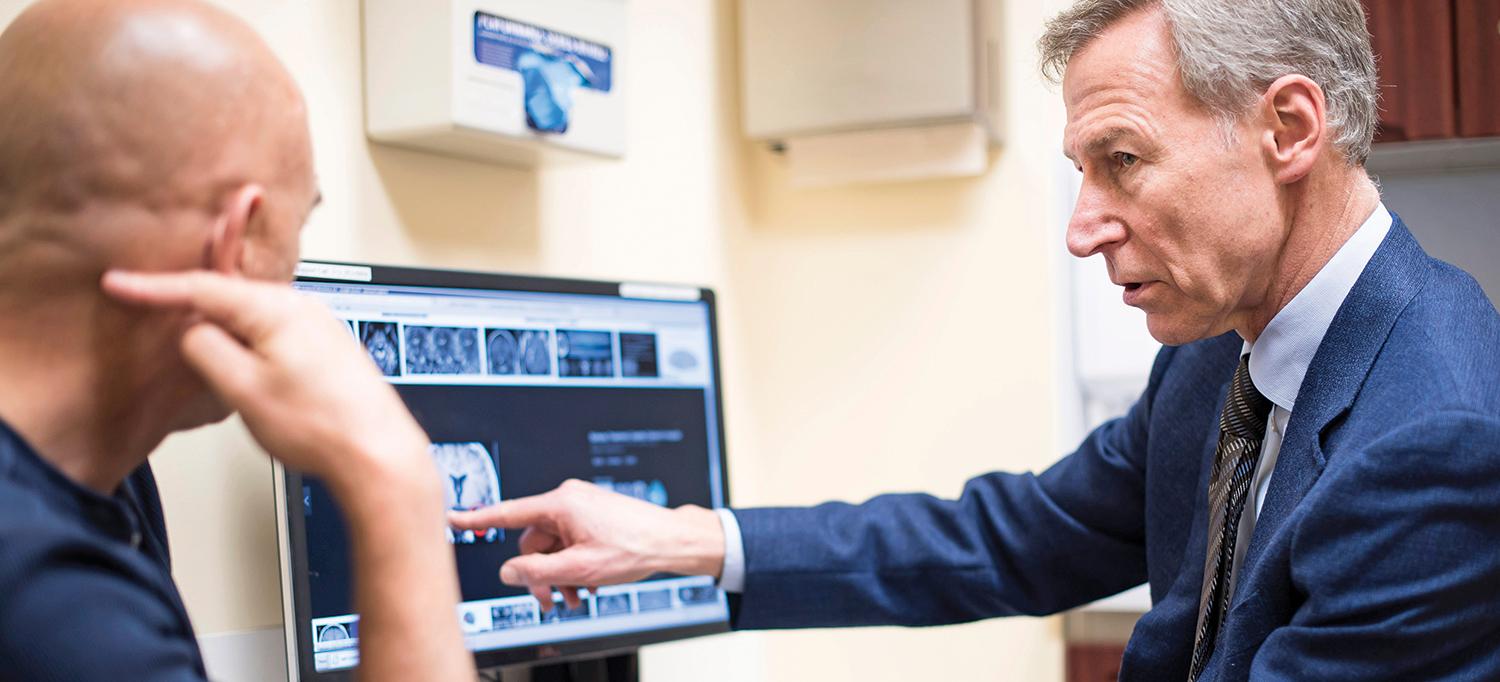
Orrin Devinsky, MD
PHOTO: Karsten Moran
A growing body of knowledge, informed by recent investigations and clinical trials at NYU Langone’s Comprehensive Epilepsy Center, could equip physicians and family members with new tools for stemming seizures and preventing sudden death in patients with epilepsy and related disorders.
Successful Cannabidiol Trial Heralds First Treatment for Dravet-Related Seizures
Epileptologists have uncovered a potential new treatment option in the cannabis-derived drug cannabidiol (Epidiolex®), shown to significantly reduce convulsive seizures related to Dravet syndrome, a rare pediatric-onset seizure disorder for which there are currently no U.S.-approved medications.
The trial, published in May 2017 in The New England Journal of Medicine, found that cannabidiol in liquid form reduced seizures in children and young adults with Dravet syndrome by 39 percent on average. Two other soon-to-be published studies found that the drug also reduced the frequency of drop seizures in individuals with Lennox–Gastaut syndrome, another form of epilepsy that often resists drug treatment.
On the basis of these studies, cannabidiol will soon be formally submitted for FDA approval as a treatment for both Dravet and Lennox–Gastaut syndromes, according to lead author Orrin Devinsky, MD, professor of neurology, neurosurgery, and psychiatry and director of the Comprehensive Epilepsy Center. “The FDA could approve it as soon as mid-2018, which would be a huge milestone,” says Dr. Devinsky. NYU Langone Health has been involved in cannabidiol’s pharmaceutical development from the very beginning, having hosted the first meeting with the drug’s manufacturer to discuss these trials five years ago.
Inhaled Alprazolam Shows Promise as a Pre-Seizure Rescue Medication
Separately, NYU Langone researchers are spearheading a phase II clinical trial testing an inhaled form of the benzodiazepine alprazolam (Xanax®) as a rescue medication for incipient seizures. “Oral benzodiazepines are already used to shorten the duration of seizure clusters, but they don’t work fast enough to actually abort a seizure when a person feels it coming on,” explains Jacqueline A. French, MD, professor of neurology and director of Translational Research and Clinical Trials at the Comprehensive Epilepsy Center. “This approach uses a device that vaporizes the medication so the lungs absorb it at a rapid rate, nearly equivalent to an intravenous dose.”
A preliminary study with individuals susceptible to light-induced seizures showed that inhaled alprazolam produced an anti-seizure effect within two minutes. Through a connection made via the NYU Langone–affiliated nonprofit Finding a Cure for Epilepsy and Seizures (FACES), researchers are now collaborating with a start-up enterprise to support the yearlong efficacy trial.
Unraveling the Mystery of Epilepsy-Related Sudden Death
Ongoing research continues to unravel the prevalence and biology of sudden unexpected death in epilepsy, or SUDEP. One finding, published in August 2017 in Neurology, suggests that the annual number of deaths from SUDEP in the United States could actually be far higher than the reported and widely accepted number of 3,000. The recalculation was based on an examination of data for all sudden cardiac deaths in the San Francisco area over a three-year period. Researchers reviewed autopsy and medical records of any decedents with a history of seizures or epilepsy, and concluded that the number of definite or possible SUDEP cases was three times greater than the number reported by the medical examiner.
“Combine this new estimate with the number of deaths of people with epileptic seizures that result in drowning, car accidents, or falls,” says Dr. Devinsky, “and it becomes clear that epilepsy-related death is an underestimated and under-addressed public health problem.”
To address this issue, researchers are studying a wrist sensor that monitors sympathetic nervous system activity via the skin. The goal is twofold: to examine the link between heightened electrodermal activity and the onset of seizures and to explore the device’s usefulness in warning family members of a potential SUDEP-causing seizure.
“Our continued research has revealed one more clue we can pursue to unravel the mystery of SUDEP,” notes Dr. Devinsky. “In time, with further resources devoted to understanding how these deaths occur, we hope to prevent them.”
Human Epilepsy Project: Hunting for Biomarkers to Overcome Treatment Resistance
In an effort to find biomarkers enabling early identification of treatment-resistant epilepsy, the Human Epilepsy Project recently enrolled 500 newly diagnosed focal-seizure epilepsy patients in a multisite study co-led by NYU Langone. For three years, researchers will follow patients in the United States, Europe, and Australia, gathering biological information including DNA and blood samples, urinalyses, EEG readings, and a special MRI evaluation while also tracking participants’ response to epilepsy medications.
This information is being logged in a data bank, where it can be mined by collaborating scientists. “We know that a third of people with epilepsy won’t respond well to any medication, but currently there’s no way to determine at the onset of treatment who they are,” says Dr. French. “This is an effort to understand the biological drivers behind that resistance.”
Three proposals from scientific groups seeking to examine specific biomarkers have been green-lit, she adds. Two will explore autoimmune factors, believed to trigger epilepsy in some cases. A third group is looking at a blood biomarker involved in inflammation, which is hypothesized to exacerbate seizures.
The project has already yielded one unexpected discovery: Many study subjects were found to have experienced subtle seizures for months or years before their epilepsy diagnosis. “People can experience numerous safety issues if their diagnosis is delayed,” notes Dr. French. “This finding indicates that we need to better help the public and the medical community to identify seizures.”


